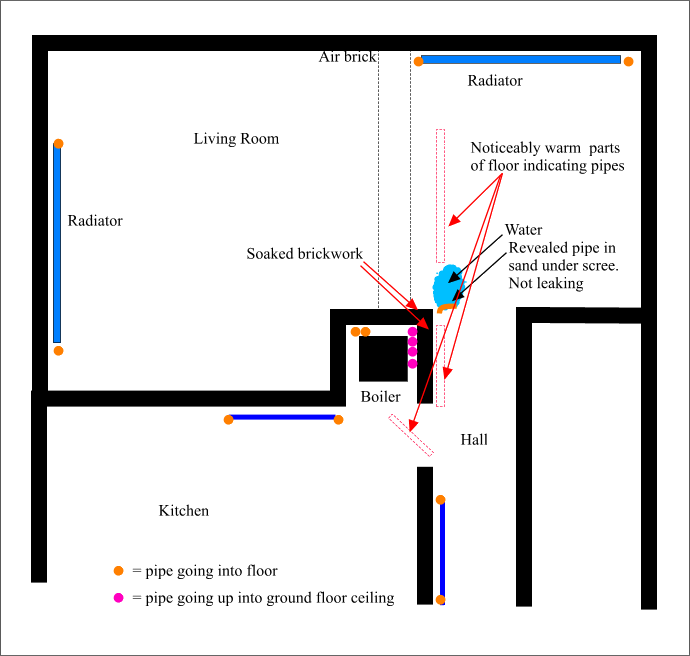- Joined
- 22 Jun 2009
- Messages
- 54
- Reaction score
- 0
- Country

I was hoping someone might be able to assist me with some hints and tips on tracking down a leak in the pipe work of my ground floor central heating.
My ground floor is the following with the leak highlighted as "water"

I would like to know if there is some sort of procedure to help me track down the source of the leak. The leak doesn't seem to be near the area around the water or the pipe next to it. I am reluctant to dig up the scree around the pipe further without some procedure to find the leak.
When I turn the heating on the water disappears and when I turn it off it reappears. The pipe is hot and so is the water when the heating is turned on. The pipe gets hot after the other radiators get warm and seems to be part of the return to the boiler. I believe other pipework exists as indicated.
The exposed pipe seems to be set in sand under the 1cm thick concrete scree which forms the floor.
I am a little confused by the turn of the exposed pipe to the right when the temperature sensations on the floor indicate the pipe would be likely to go to the radiator at the top of the diagram.
Do I need some sort of water dye to put into the water to help me see where the water is coming from?
Do I need some sort of air pressure device to flush out water from pipework when I do the find leak and attempt to fix it by brazing new pipework or whatever ?
Any help appreciated.
My ground floor is the following with the leak highlighted as "water"

I would like to know if there is some sort of procedure to help me track down the source of the leak. The leak doesn't seem to be near the area around the water or the pipe next to it. I am reluctant to dig up the scree around the pipe further without some procedure to find the leak.
When I turn the heating on the water disappears and when I turn it off it reappears. The pipe is hot and so is the water when the heating is turned on. The pipe gets hot after the other radiators get warm and seems to be part of the return to the boiler. I believe other pipework exists as indicated.
The exposed pipe seems to be set in sand under the 1cm thick concrete scree which forms the floor.
I am a little confused by the turn of the exposed pipe to the right when the temperature sensations on the floor indicate the pipe would be likely to go to the radiator at the top of the diagram.
Do I need some sort of water dye to put into the water to help me see where the water is coming from?
Do I need some sort of air pressure device to flush out water from pipework when I do the find leak and attempt to fix it by brazing new pipework or whatever ?
Any help appreciated.

